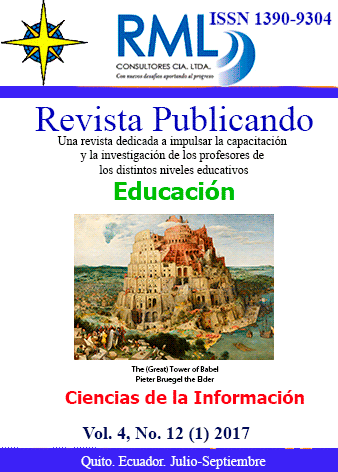Resumen
La Ingeniería de Software (IS) es la utilización de un enfoque metódico, cuidadoso y cuantificable al desarrollo, operación y mantenimiento de software, y el estudio de estas direcciones, es decir, el estudio de las aplicaciones de la ingeniería al software. Agrupa asignaturas como matemáticas, ciencias de la computación y prácticas cuyos orígenes se encuentran en la ingeniería. La IS se puede considerar como la ingeniería aplicada al software, esto es, por medios sistematizados y con herramientas preestablecidas, la aplicación de ellos de la manera más eficiente para la obtención de resultados óptimos; objetivos que siempre busca la ingeniería. No es sólo de la resolución de problemas, sino más bien teniendo en cuenta las diferentes soluciones, elegir la más apropiada.
La presente contribución científica destaca las aristas y proyecciones de esta disciplina mediante un estudio bibliográfico confinado al directorio académico Scopus, y solo a trabajos socializados en idioma inglés. Los principales resultados de la investigación apuntaron a que la Ingeniería de Software (IS) se ha convertido en la forma predominante del desarrollo de software para empresas internacionales y ha dado lugar a una demanda de estudiantes formados en esta materia.
Referencias
Alaya, Z., Chemek, A., El Khil, G. K., Ben Aissa, M., & Marzouk, A. (2017) An integrated project for freshmen students in a software engineering education. Vol. 544 (pp. 209-216): Springer Verlag.
Beslmeisl, M., Reuter, R., & Mottok, J. (2017) The importance of writing in software engineering education. Vol. 544 (pp. 315-321): Springer Verlag.
Bollin, A., Pasterk, S., Antonitsch, P., & Sabitzer, B. (2016). Software engineering in primary and secondary schools-Informatics education is more than programming.
Clear, T., Beecham, S., Barr, J., Daniels, M., McDermott, R., Oudshoorn, M., . . . Noll, J. (2015). Challenges and recommendations for the design and conduct of global software engineering courses: A systematic review. Paper presented at the Proceedings of the 2015 ITiCSE on Working Group Reports.
Clear, T., Beecham, S., Barr, J., Daniels, M., Oudshoorn, M., & Noll, J. (2016). Developments in Global Software Engineering Education. Paper presented at the Frontiers in Education Conference (FIE), 2016 IEEE.
Daniels, M. (2011). Developing and Assessing Professional Competencies: a Pipe Dream?: Experiences from an Open-Ended Group Project Learning Environment. Acta Universitatis Upsaliensis.
Daniels, M., Cajander, í…., Pears, A., & Clear, T. (2010). Engineering education research in practice: Evolving use of open ended group projects as a pedagogical strategy for developing skills in global collaboration. International Journal of Engineering Education, 26(4), 795-806.
Gallant, R. (2016). Thinking Fast: Patterns of Cognitive Error in Software Engineering Education and Practice.
Gold-Veerkamp, C., Abke, J., & Diethelm, I. (2016). A research approach to analyse and foster discipline-specific language competency in software engineering education.
Hoda, R., Babar, M. A., Shastri, Y., & Yaqoob, H. (2016). Socio-Cultural Challenges in Global Software Engineering Education. IEEE Transactions on Education. doi:10.1109/TE.2016.2624742
Kadenbach, D., & Kleiner, C. (2016) Evaluation of collaborative development environments for software engineering courses in higher education. Vol. 9742 (pp. 365-372): Springer Verlag.
Kalles, D. (2016). Artificial intelligence meets software engineering in computing education.
Marques, M., Ochoa, S. F., & Bastarrica, M. C. (2016). Software engineering education in Chile - Status report.
Monasor, M. J., Vizcaíno, A., Piattini, M., Noll, J., & Beecham, S. (2013). Simulating global software development processes for use in education: A feasibility study. Paper presented at the European Conference on Software Process Improvement.
Mujkanovic, A., & Bollin, A. (2016). Improving learning outcomes through systematic group reformation: The role of skills and personality in software engineering education.
Pieper, J., Lueth, O., Goedicke, M., & Forbrig, P. (2017). A case study of software engineering methods education supported by digital game-based learning: Applying the SEMAT Essence kernel in games and course projects.
Shuto, M., Washizaki, H., Kakehi, K., Fukazawa, Y., Yamato, S., & Okubo, M. (2016). Learning effectiveness of team discussions in various software engineering education courses.
Silva, D., Nunes, I., & Terra, R. (2017). Investigating code quality tools in the context of software engineering education. Computer Applications in Engineering Education, 25(2), 230-241. doi:10.1002/cae.21793
Sureephong, P., & Singjai, A. (2016) SaaS for education: A case study of Google apps in software engineering class. Vol. 467 (pp. 631-639): Springer New York LLC.
Suri, B., Jatana, N., & Tomer, M. (2016). Towards advancement of education in Software Engineering.
Torre, D., Procaccianti, G., Fucci, D., Lutovac, S., & Scanniello, G. (2017). On the presence of green and sustainable software engineering in higher education curricula.
Work in progress: Teaching-obstacles in higher software engineering education. (2017).
Wrycza, S., Marcinkowski, B., & Gajda, D. (2017). The Enriched UTAUT Model for the Acceptance of Software Engineering Tools in Academic Education. Information Systems Management, 34(1), 38-49. doi:10.1080/10580530.2017.1254446
Usted es libre de:
Compartir — copiar y redistribuir el material en cualquier medio o formato
Adaptar — remezclar, transformar y construir a partir del material
La licenciante no puede revocar estas libertades en tanto usted siga los términos de la licencia
Bajo los siguientes términos:
Atribución — Usted debe dar crédito de manera adecuada, brindar un enlace a la licencia, e indicar si se han realizado cambios. Puede hacerlo en cualquier forma razonable, pero no de forma tal que sugiera que usted o su uso tienen el apoyo de la licenciante.
NoComercial — Usted no puede hacer uso del material con propósitos comerciales.
CompartirIgual — Si remezcla, transforma o crea a partir del material, debe distribuir su contribución bajo la lamisma licencia del original.
